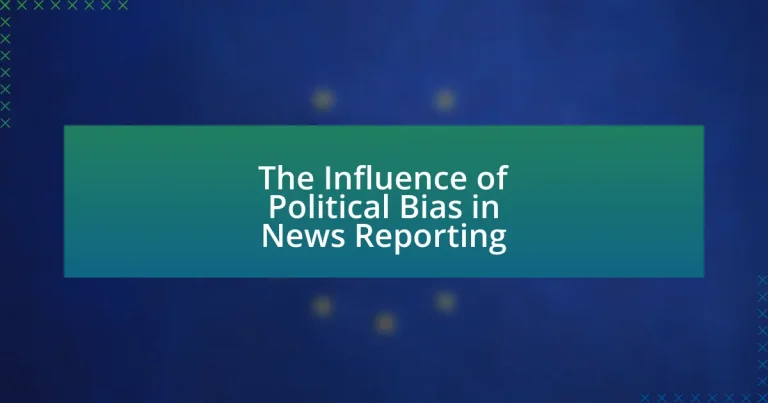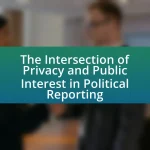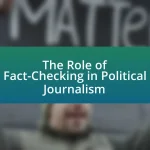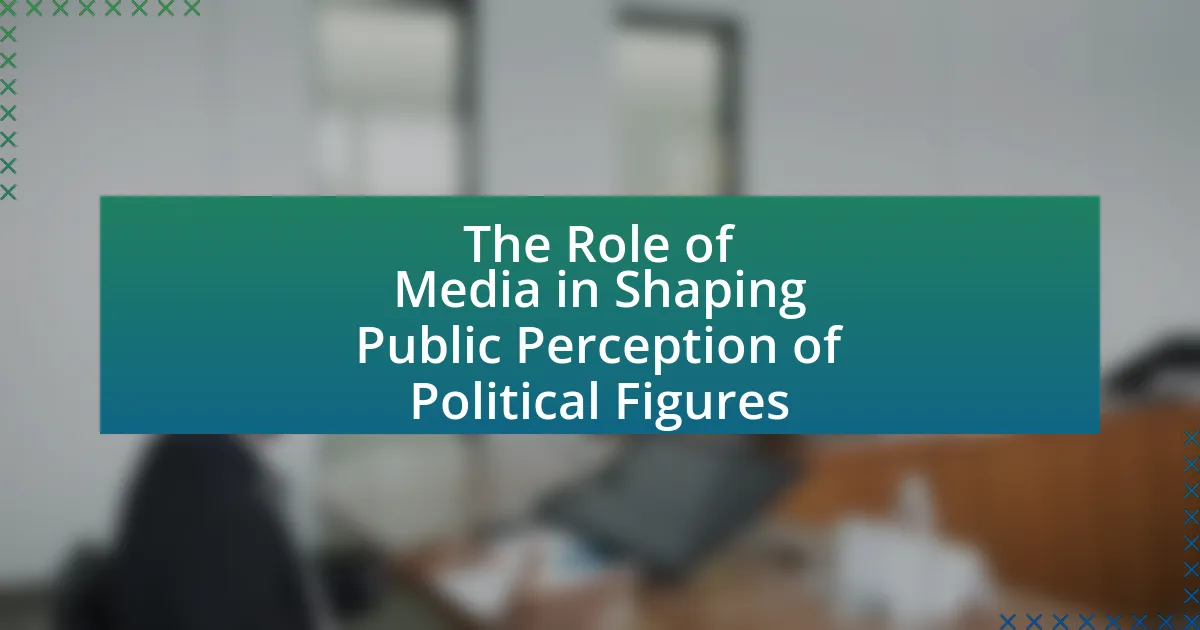The article examines the influence of political bias in news reporting, highlighting how such bias shapes public perception and opinion. It discusses the manifestations of political bias, including selective coverage, framing, and language choices that favor specific political perspectives. Key indicators of bias, such as selective reporting and emotionally charged language, are analyzed, along with the impact of media ownership and funding on news narratives. The article also explores the effects of political bias on voter behavior, journalistic integrity, and public trust, while providing strategies for consumers to identify and mitigate bias in news reporting.
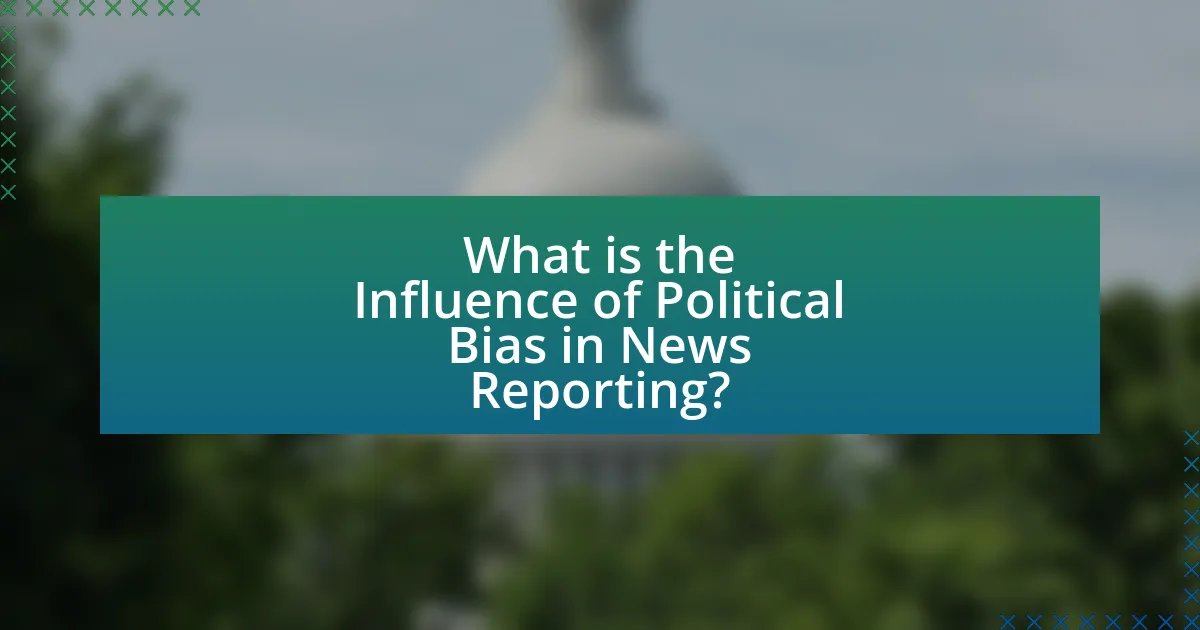
What is the Influence of Political Bias in News Reporting?
Political bias in news reporting significantly shapes public perception and opinion. This bias can lead to selective coverage, framing of issues in a particular light, and the omission of critical facts, ultimately influencing how audiences interpret events and policies. Research by the Pew Research Center indicates that individuals often consume news that aligns with their pre-existing beliefs, reinforcing their views and contributing to polarization. For example, studies show that partisan news outlets tend to emphasize stories that resonate with their political affiliations, which can distort the public’s understanding of important issues.
How does political bias manifest in news reporting?
Political bias in news reporting manifests through selective coverage, framing, and language choices that favor one political perspective over another. For instance, a study by the Pew Research Center found that news outlets often emphasize stories that align with their ideological leanings, leading to a disparity in the representation of events. Additionally, the choice of words and tone can subtly influence audience perception; for example, describing a protest as “peaceful” versus “chaotic” can shape public opinion differently. These practices contribute to a polarized media landscape, where audiences receive information that reinforces their existing beliefs rather than providing a balanced view.
What are the common indicators of political bias in news articles?
Common indicators of political bias in news articles include selective reporting, language choice, and framing. Selective reporting occurs when certain facts or perspectives are emphasized while others are downplayed or omitted, leading to a skewed representation of events. Language choice involves the use of emotionally charged or loaded terms that can influence readers’ perceptions, such as describing a protest as a “riot” versus a “demonstration.” Framing refers to how information is presented, which can shape the audience’s understanding and interpretation of an issue. For example, framing a tax policy as a “burden” versus a “contribution” can reflect a particular political stance. These indicators are supported by studies, such as the Pew Research Center’s analysis on media bias, which highlights how different outlets prioritize and present news stories based on their political affiliations.
How do language and tone reflect political bias?
Language and tone reflect political bias by shaping perceptions and framing narratives in a way that aligns with specific ideological viewpoints. For instance, the choice of words such as “freedom fighter” versus “terrorist” can significantly influence public opinion about a political group. Research by the Pew Research Center indicates that media outlets often use emotionally charged language to appeal to their audience’s beliefs, thereby reinforcing existing biases. This selective language and tone not only affect how information is interpreted but also contribute to the polarization of public discourse, as seen in the differing portrayals of political events across various news platforms.
Why is political bias in news reporting significant?
Political bias in news reporting is significant because it shapes public perception and influences political behavior. When news outlets present information with a particular ideological slant, they can affect how audiences interpret events, policies, and political figures. Research indicates that biased reporting can lead to increased polarization among the public, as individuals gravitate towards sources that reinforce their existing beliefs, thereby limiting exposure to diverse viewpoints. For instance, a study by the Pew Research Center found that partisan media consumption correlates with heightened political division, demonstrating the tangible impact of biased reporting on societal discourse.
What impact does political bias have on public perception?
Political bias significantly shapes public perception by influencing how information is interpreted and understood. When news outlets exhibit political bias, they often frame stories in a way that aligns with specific ideological viewpoints, which can lead to selective reporting and the omission of critical facts. For example, a study by the Pew Research Center found that individuals who consume news from sources with a particular political slant are more likely to adopt similar views and exhibit polarized opinions on key issues. This phenomenon occurs because biased reporting can reinforce existing beliefs, creating echo chambers that distort public understanding of events and issues.
How does political bias influence voter behavior?
Political bias significantly influences voter behavior by shaping perceptions and attitudes toward candidates and policies. Research indicates that individuals exposed to biased news sources tend to align their voting preferences with the ideological slant of those sources. For instance, a study by the Pew Research Center found that 62% of Americans believe that news organizations favor one side in their reporting, which can lead to increased polarization and reinforce existing beliefs. This bias affects not only the information voters receive but also their emotional responses, ultimately guiding their electoral choices.
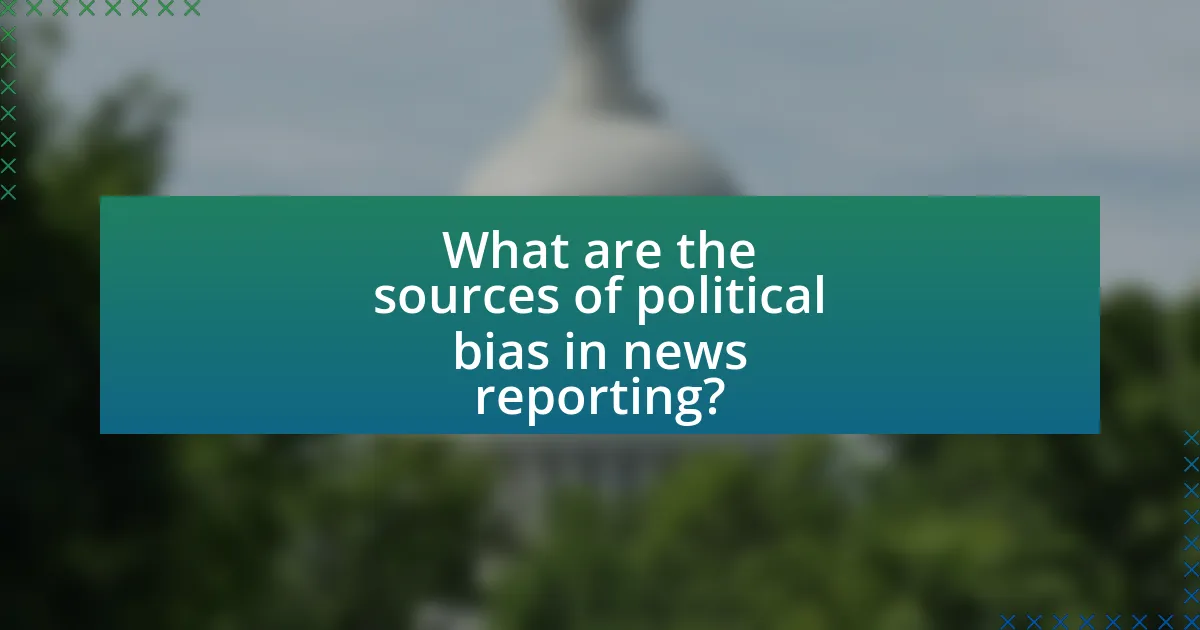
What are the sources of political bias in news reporting?
Political bias in news reporting primarily originates from the ownership and funding of media outlets, editorial choices, and the personal beliefs of journalists. Media ownership often influences content, as owners may have specific political affiliations that shape the narratives presented. For instance, studies have shown that news organizations owned by individuals or corporations with political interests tend to reflect those biases in their reporting. Additionally, editorial decisions regarding which stories to cover and how to frame them can introduce bias, as editors may prioritize certain viewpoints over others. Furthermore, journalists’ own political beliefs can unconsciously affect their reporting, leading to a skewed representation of facts. Research indicates that journalists with strong political affiliations may exhibit bias in their choice of sources and language, further impacting the objectivity of news coverage.
How do media ownership and funding contribute to bias?
Media ownership and funding significantly contribute to bias by shaping the narratives and perspectives presented in news reporting. When a small number of corporations or individuals own media outlets, their interests and ideologies can dominate the content, leading to selective coverage that aligns with their agendas. For instance, a study by the Pew Research Center found that media outlets owned by large conglomerates often reflect the political and economic interests of their owners, which can skew public perception and limit diversity of viewpoints. Additionally, funding sources, such as advertising revenue or donations from politically aligned organizations, can pressure media organizations to prioritize certain stories or angles, further entrenching bias. This dynamic creates an environment where the information disseminated to the public may not represent a balanced view, but rather a filtered narrative that serves specific interests.
What role does corporate ownership play in shaping news narratives?
Corporate ownership significantly influences news narratives by prioritizing the interests of owners over journalistic integrity. This ownership structure often leads to editorial decisions that align with the political and economic agendas of the corporations, resulting in biased reporting. For instance, a study by the Pew Research Center found that 77% of journalists believe that corporate ownership pressures them to avoid certain topics or angles that may conflict with the interests of their owners. This dynamic can lead to the underreporting of critical issues or the framing of news in a way that supports corporate narratives, thereby shaping public perception and discourse.
How does advertising influence editorial decisions?
Advertising significantly influences editorial decisions by creating financial dependencies that can shape content and coverage. Media outlets often rely on advertising revenue for their operational budgets, which can lead to a prioritization of advertiser interests over journalistic integrity. For instance, studies have shown that news organizations may avoid critical reporting on advertisers or their industries to maintain lucrative relationships, thereby compromising editorial independence. This dynamic can result in biased reporting, as seen in cases where major corporations influence the framing of news stories to align with their business interests, ultimately affecting the objectivity of the information presented to the public.
What are the effects of political bias on journalistic integrity?
Political bias undermines journalistic integrity by compromising objectivity and accuracy in reporting. When journalists exhibit political bias, they may selectively present information, leading to skewed narratives that misinform the public. Research indicates that biased reporting can erode trust in media institutions; for instance, a 2017 study by the Pew Research Center found that 62% of Americans believe news organizations favor one side in political debates. This perception of bias can diminish the credibility of news outlets, as audiences may question the reliability of information presented. Furthermore, political bias can result in the omission of critical viewpoints, thereby limiting the diversity of perspectives necessary for informed public discourse.
How does bias affect the credibility of news organizations?
Bias significantly undermines the credibility of news organizations by leading to selective reporting and misrepresentation of facts. When news outlets exhibit political bias, they often prioritize stories that align with their ideological stance while ignoring or downplaying opposing viewpoints. This selective coverage can distort public perception and erode trust among audiences. For instance, a 2020 study by the Pew Research Center found that 62% of Americans believe that news organizations are biased in their reporting, which directly correlates with a decline in trust in media sources. Consequently, biased reporting not only affects the perceived reliability of the news but also contributes to the polarization of public opinion, as audiences gravitate towards sources that reinforce their beliefs rather than challenge them.
What ethical dilemmas arise from biased reporting?
Biased reporting leads to several ethical dilemmas, primarily the distortion of truth and the erosion of public trust. When news outlets present information with a political bias, they often prioritize sensationalism over factual accuracy, which can mislead audiences and shape public opinion based on false narratives. This practice undermines journalistic integrity, as evidenced by studies showing that biased reporting can significantly influence voter behavior and perceptions of political issues. For instance, research by the Pew Research Center indicates that individuals exposed to biased news are more likely to hold polarized views, further complicating the media’s role as an impartial informant in a democratic society.
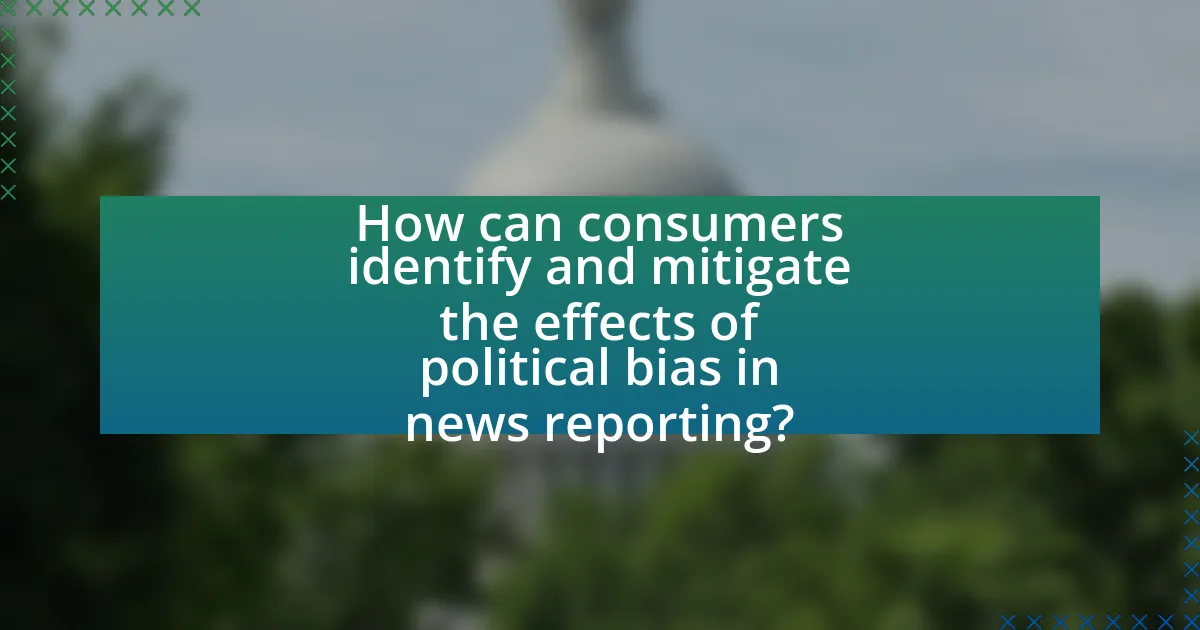
How can consumers identify and mitigate the effects of political bias in news reporting?
Consumers can identify and mitigate the effects of political bias in news reporting by critically evaluating sources, cross-referencing information, and seeking diverse perspectives. Critical evaluation involves assessing the credibility of news outlets, recognizing their ownership and funding, which can influence editorial slant. Cross-referencing information with multiple reputable sources helps to verify facts and identify discrepancies that may indicate bias. Seeking diverse perspectives, including those from different political viewpoints, allows consumers to gain a more balanced understanding of issues. Research indicates that exposure to a variety of news sources can reduce the impact of bias on public opinion, as demonstrated in studies by the Pew Research Center, which found that individuals who consume news from multiple outlets are more informed and less likely to hold extreme views.
What strategies can readers use to recognize bias in news sources?
Readers can recognize bias in news sources by critically evaluating the language used, assessing the diversity of sources, and checking for factual accuracy. Analyzing the language involves identifying emotionally charged words or phrases that may indicate a slant, such as “radical” versus “progressive.” Assessing the diversity of sources means looking for a range of perspectives, as reliance on a single viewpoint can signal bias. Checking for factual accuracy includes verifying claims against reputable fact-checking organizations, which can reveal discrepancies or misleading information. For instance, a study by the Pew Research Center found that news outlets with a clear ideological stance often present information selectively, reinforcing the importance of cross-referencing multiple sources to gain a balanced understanding.
How can cross-referencing multiple news outlets reduce bias perception?
Cross-referencing multiple news outlets can reduce bias perception by providing a more comprehensive view of events and issues. When individuals consume news from various sources, they are exposed to different perspectives, which helps to identify discrepancies and commonalities in reporting. This practice encourages critical thinking and allows consumers to discern potential biases inherent in any single outlet. Research indicates that individuals who engage in cross-referencing are less likely to hold polarized views, as they are better equipped to evaluate information objectively. For instance, a study by the Pew Research Center found that people who follow diverse news sources are more informed and less likely to perceive bias in news reporting.
What tools are available to help identify biased reporting?
Tools available to help identify biased reporting include media bias rating websites, fact-checking organizations, and automated bias detection algorithms. Websites like Media Bias/Fact Check provide assessments of news sources based on their political leanings and factual accuracy. Fact-checking organizations such as Snopes and PolitiFact evaluate claims made in news articles for truthfulness, helping to highlight potential bias. Additionally, automated algorithms, like those developed by researchers at the University of Michigan, analyze language patterns in news articles to detect bias, providing a quantitative approach to identifying biased reporting. These tools collectively enhance the ability to discern bias in news media.
What best practices can journalists adopt to minimize political bias?
Journalists can minimize political bias by adhering to principles of objectivity, fact-checking, and diverse sourcing. Objectivity requires journalists to present information without personal opinions influencing the narrative, ensuring that all sides of a political issue are represented fairly. Fact-checking is essential; according to a study by the American Press Institute, accurate reporting builds trust and credibility, which helps mitigate bias. Additionally, utilizing diverse sources, including voices from various political perspectives, allows for a more balanced representation of issues, as highlighted in research by the Pew Research Center, which found that exposure to multiple viewpoints reduces perceived bias in reporting.
How can transparency in reporting enhance trustworthiness?
Transparency in reporting enhances trustworthiness by providing clear, accessible information about sources, methodologies, and potential biases. When news organizations openly disclose their processes and the origins of their information, audiences can better evaluate the credibility of the content. For instance, a study by the Pew Research Center found that 70% of Americans believe that transparency about sources increases trust in news organizations. This level of openness allows consumers to make informed judgments, thereby fostering a more trusting relationship between the media and the public.
What role does fact-checking play in reducing bias?
Fact-checking plays a crucial role in reducing bias by verifying the accuracy of information presented in news reporting. By systematically assessing claims made by public figures and media outlets, fact-checking helps to identify misinformation and promote accountability. Research from the Pew Research Center indicates that fact-checking can enhance public trust in media, as audiences are more likely to rely on sources that demonstrate a commitment to accuracy. Furthermore, studies show that exposure to fact-checked information can lead to a decrease in partisan bias, as individuals are confronted with objective data rather than subjective interpretations.
How can individuals engage critically with news to combat bias?
Individuals can engage critically with news to combat bias by actively seeking diverse sources of information and analyzing the framing of news stories. By consuming news from various outlets, individuals can compare different perspectives and identify potential biases in reporting. Research indicates that exposure to a range of viewpoints enhances critical thinking and reduces susceptibility to misinformation. For example, a study published in the journal “Communication Research” found that individuals who engage with multiple news sources are better equipped to recognize bias and evaluate the credibility of information. This approach fosters a more informed understanding of current events and encourages individuals to question the narratives presented in the media.
